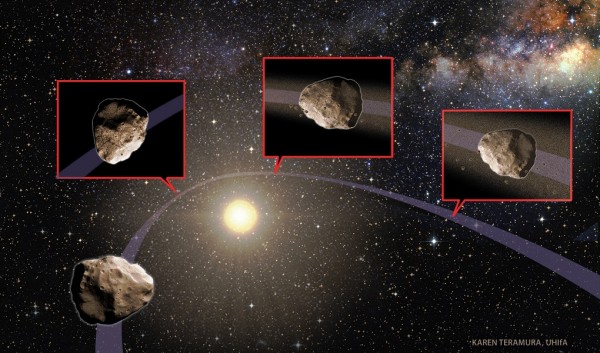By Ana Verayo, | February 18, 2016

An asteroid's orbit is altered as it passes close to Jupiter, Earth or Venus, such that its new orbit takes it near the Sun. The intense heat from the Sun causes the asteroid's surface to expand and fracture, and some of the material breaks off.
Astronomers reveal in a new study how near Earth asteroids apparently die out in deep space as opposed to the common belief that they plunge to their deaths into the fiery surface of the sun.
Like Us on Facebook
Scientists examined the crucial properties of almost 9,000 near Earth objects which are composed of asteroids, meteorites and space debris that are flying near the planet, at about 1.3 Earth to sun distances, in order to develop and build a model of this near Earth object population.
However, this new asteroid model appears to be problematic, as it predicted that the amount of near Earth objects should be 10 times more that are approaching the sun at an estimated distance of 9 million miles, than the amount yielded by current observations.
The team apparently spent an intensive year of research before they finally released their results revealing that these missing near Earth objects are disappearing by disintegrating or getting destroyed as they get closer to the sun, even before they make a final death dive into the star.
According to co-author of the study, Robert Jedicke from the University of Hawaii Institute for Astronomy, this remarkable discovery of how asteroids break up when they are approaching the sun too closely is really surprising, since intensive calculations and analyses were carried out to verify these results.
This new model can also help astronomers and scientists for future research about near Earth object populations. Researchers also say that since most meteors that enter the planet and light up the sky originate from parent near Earth objects as these meteors fall from them while orbiting the sun.
These debris clouds also follow the same orbits as their parent bodies however, astronomers have a hard time finding these objects. In this new study, parent objects are hard to find since they have already been destroyed.
Scientists also determined how darker near Earth objects also die from a farther distance from the sun compared to brighter ones which confirms how asteroids that are brighter can be found nearer the sun, appearing to quite bright.
This new finding means that darker and brighter asteroids could possess significantly different structures and compositions. According to lead author of the study, Mikael Granvik from the University of Helsinki in Finland, the most crucial and truly remarkable outcome of this study is that it is now possible to test models of asteroids just by monitoring their orbits and sizes.
This new model took eight years to build where Granvik and his team developed their model from studying almost 100,000 images of near Earth objects based on data from the Catalina Sky Survey in Arizona.
Currently, there are now 14,000 near Earth objects that have been identified and tracked but its overall population numbers could reach millions. Astronomers believe that these bodies first develop from the main asteroid belt between Mars and Jupiter as they get reeled in due to strong gravitational forces by Jupiter and Saturn.
This new study is published in the journal Nature.
-
Use of Coronavirus Pandemic Drones Raises Privacy Concerns: Drones Spread Fear, Local Officials Say

-
Coronavirus Hampers The Delivery Of Lockheed Martin F-35 Stealth Fighters For 2020

-
Instagram Speeds Up Plans to Add Account Memorialization Feature Due to COVID-19 Deaths

-
NASA: Perseverance Plans to Bring 'Mars Rock' to Earth in 2031

-
600 Dead And 3,000 In The Hospital as Iranians Believed Drinking High-Concentrations of Alcohol Can Cure The Coronavirus

-
600 Dead And 3,000 In The Hospital as Iranians Believed Drinking High-Concentrations of Alcohol Can Cure The Coronavirus

-
COVID-19: Doctors, Nurses Use Virtual Reality to Learn New Skills in Treating Coronavirus Patients







